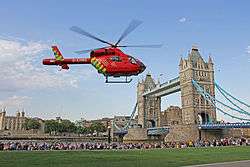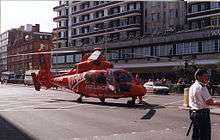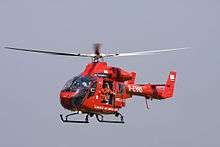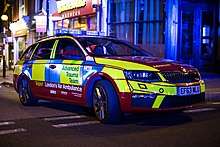London's Air Ambulance Charity
London's Air Ambulance Charity is a registered charity that operates a helicopter emergency medical service (HEMS) dedicated to responding to serious trauma emergencies in and around London.[2] Using a helicopter from 08:00 to sunset and rapid response vehicles by night, the service performs advanced medical interventions at the scene of the incident in life-threatening, time-critical situations.
 | |
| Founded | 1989 |
|---|---|
| Type | Charitable organisation |
| Location | |
| Coordinates | 51.5180°N 0.0583°W |
Area served | Greater London |
Medical director | Dr Gareth Davies |
CEO | Jonathan Jenkins |
| Website | www |
The charity was founded in 1989 in response to a report by the Royal College of Surgeons, which documented cases of patients dying unnecessarily because of the delay in receiving prompt and appropriate medical care. The charity was the first in the UK to carry a senior doctor in addition to a paramedic at all times on a helicopter, introducing a system that reduces the death rate in severe trauma by 30–40%.[3]
The helicopters are hangared at RAF Northolt,[4] but operate during the day From their base at the Royal London Hospital in Whitechapel, East London, a helicopter can reach any patient inside the M25 London orbital motorway, which acts as the service's catchment area, within 15 minutes. Missions commonly involve serious road traffic collisions, falls from height, stabbings and shootings, industrial accidents and incidents on the rail network. The team can perform advanced life-saving medical interventions, including open heart surgery, blood transfusion and anaesthesia, at the scene. The charity operates 24 hours a day, serving the 10 million people who live, work and travel within the M25. The service treats an average of five patients every day.
Pre-hospital emergency medical care

London's Air Ambulance Charity has been at the forefront of innovation in pre-hospital emergency medical care since its inception in 1989. The service has adopted elements of medical, military and aviation culture to deliver the highest standards in intensive care to the roadside. The governance system and Standard Operating Procedures developed by the organisation are seen as a benchmark for other air ambulances across the world.
London's Air Ambulance carries a senior doctor in addition to a paramedic at all times, providing a 24/7 advanced trauma care outside of hospital, provide general anaesthetics on scene, and carry blood on board and administer blood transfusion on the roadside. From 2018, a consultant in pre-hospital emergency medicine will be present on most shifts, in addition to the other physician and paramedic.
In 2014, London's Air Ambulance performed the first pre-hospital resuscitative endovascular balloon occlusion of the aorta (REBOA).[5][6][7] Other key treatments performed by the service include surgical chest draining (thoracostomy), surgical and non-surgical rapid sequence induction (RSI), pelvic splinting (crucial to prevent blood loss in high impact crashes and crush injuries), advanced pain relief and sedation. The service started a trial of a portable brain scanner which can detect blood clots on the brain in April 2015.[8]
Aircraft
Aerospatiale Dauphin N2

The service's first helicopter was an Aérospatiale SA 365N Dauphin N2. Built in 1982, it was registered G-HEMS, and delivered in December 1988, in time for the launch of the service in 1989.[9][10] It initially wore a white livery, but was repainted several times, eventually into a red livery following sponsorship by Virgin.[11] It was retired from service in 2000.
MD 902 Explorer
Two MD Helicopters MD 902 Explorers are currently in service, registrations G-EHMS and G-LNDN. Both wear the same red-based livery, with green and yellow flashes, and are identical in model, equipment and crew. Only one helicopter is operational per day – the other acts as a spare in case of break down, maintenance or, in a major incident, both helicopters are able to deploy. The helicopters usually cruise at 130 knots (240 km/h; 150 mph), at an altitude of anywhere between 500 and 1,000 feet (150 and 300 m). A regular fuel load, around 400 kg (880 lb), allows for one hour's flying time.[12]
Following a children's competition, the two helicopters were given names which are displayed on the side of each aircraft. In February 2016, G-LNDN was named Walter after the winning entrant's grandfather, whilst G-EHMS was named Rowan in April 2016 after the winning entrant's sister.[13][14]
G-EHMS Rowan

G-EHMS was built in 2000 and entered service in October of the same year, replacing the earlier SA 365N Dauphin 2. From 6 March 2012, the helicopter became the UK's first air ambulance to carry emergency blood supplies, allowing transfusions to be administered at the scene of an accident rather than later in hospital.[15] A specialised refrigerator installed in the helicopter allows the transport of four units of the universal O-negative blood type which can be stored in the aircraft for up to 72 hours (unused stocks can be returned to the hospital).
G-LNDN Walter
.jpg)
In 2015, the service launched a public appeal to raise £6 million to purchase, convert, equip, and operate a second helicopter. Of the total needed, just over £4M represented the purchase price of the aircraft.[16] £2M was donated by the London Freemasons,[17][18] which covered half the purchase price. The United Kingdom Government contributed £1M using funds obtained from fines imposed on banks,[18] with the remaining £1M being raised by public subscription.
In January 2016, the service took delivery of its second MD 902, registration G-LNDN. Built in 2008, the aircraft was previously registered in Qatar.[19] In addition to the standard livery, it bears the masonic Square and Compasses symbol on each side, with the words "London Freemasons" lettered under the doors, to reflect the significant funding from the organisation.
Rapid response cars

At night, or when the helicopters are offline the medical crew, including a paramedic and senior trauma doctor, still respond to emergencies, but travel in a specially equipped rapid response car. They are noticeable from other ambulance vehicles as they are painted in red with high-visibility markings to display their advanced trauma team status.
A four-wheel drive Skoda Kodiaq estate is also operated seven days a week by the Physician Response Unit (PRU).
Funding
The service costs approximately £10M per year to run. Barts Health NHS Trust provides the helipad facility at The Royal London Hospital and remunerates the doctors seconded to and consultants permanently associated with the service.[20] London Ambulance Service employs and remunerates the paramedics seconded to the service.[21] London's Air Ambulance is a registered charity (number 801013) and the service is funded through charitable donations and corporate donors. The charity also runs a lottery for £1 a week to raise funds for the service, and holds a number of small and large scale fundraising events throughout the year.
Missions and major incidents
London's Air Ambulance has attended more than 38,000 missions since its inception in 1989. In 2017, London's Air Ambulance attended 1,797 patient missions and three major incidents.
- 533 Road traffic collisions
- 560 Penetrating trauma (stabbings and shootings)
- 412 Falls from height
- 292 Other (incidents on the rail network, industrial accidents, asphyxiation, drowning etc.)
Over the past 29 years, the service has coordinated medical response to the majority of London's major incidents, including the 7/7 bombings, the Soho nail bombing, the Grenfell Tower fire, the Bishopsgate, Aldwych, Westminster and London Bridge terrorist attacks and Paddington, Cannon Street and Southall rail crashes. On 7 July 2005, London's Air Ambulance dispatched 18 teams and flew medical supplies to the bomb sites across London, triaging and treating over 700 patients.
Crew
The helicopter crew consists of a pilot and co-pilot, in addition to an advanced trauma doctor, paramedic and, on most missions, a consultant. At night or in adverse weather conditions, the same medical crew operate from a rapid response car, which is driven by the paramedic on blue lights and navigated by the doctor.
Helipad fire & rescue
On arrival at the Royal London Hospital helipad, the dedicated helipad ground crew (fire crew) receive the patient and a dedicated, express elevator carries the patient to the accident and emergency department on the ground floor – where a trauma team with A&E doctors, general surgeons, specialist trauma surgeons, and anaesthetists assemble to assess and treat them.
Fire crew must always be present when a helicopter lands or takes off from the helipad.
Television appearances
In 2004, the service was featured heavily in the BBC television series Trauma.[22] In 2009, a standalone documentary about the air ambulance was made for the BBC by North One Television. Medic One: Life and Death in London showcased the service in a number of emergencies.[23] In 1994, they featured in a special episode of the BBC series 999 entitled "The Flying Doctors". They also featured in BBC Two's An Hour to Save Your Life.
Administration
The HEMS Medical Director is Dr. Gareth Davies. Davies is also an Accident & Emergency and Pre-hospital Care Consultant working at The Royal London Hospital.
Concerns were expressed in the media after the charity dismissed its Chief Executive in 2009.[24] The Charity Commission promptly made recommendations on governance to the trustees, but did not express an opinion over the dismissal.[25]
Physician Response Unit
The Physician Response Unit (PRU) is run by the service in partnership with Barts Health NHS Trust and London Ambulance Service NHS Trust. The service was remodelled in October 2017 to become a 12-hours a day, seven days a week service thanks to funding from Tower Hamlets Together.[26]
The PRU is staffed by a senior doctor and a London Ambulance Service EAC. The PRU carries advanced medication, equipment and treatments usually only found in hospital, such as instant result blood tests, urine tests and sutures to stitch serious wounds. In the remodelled service's first six months, 68% of patients were treated in the community.[27]
See also
References
- https://www.londonsairambulance.org.uk/news-and-stories/charity/move-to-raf-northolt
- "Helicopter Emergency Medical Service (HEMS) - Barts and the London NHS Trust". Bartsandthelondon.nhs.uk. Retrieved 22 February 2012.
- Botker et al. "A systematic review of controlled studies: Do physicians increase survival with pre-hospital treatment?" Scandinavian Journal of Trauma, Resuscitation and Emergency Medicine 2009, 17:12.
- "Move to RAF Northolt". London’s Air Ambulance. 21 October 2013. Retrieved 7 June 2020.
- "REBOA: Resuscitative Endovascular Balloon Occlusion of the Aorta". Retrieved 12 August 2016.
- "World's first pre-hospital REBOA performed". Retrieved 12 August 2016.
- "Balloon surgery stops fatal bleeding at roadside". BBC News. 17 June 2014. Retrieved 12 August 2016.
- "Portable brain scanner trialled by London's Air Ambulance". BBC News. 30 December 2015. Retrieved 1 January 2016.
- https://www.helis.com/database/cn/25858/
- https://londonsairambulance.co.uk/our-service/our-work/history/timeline#12
- https://londonsairambulance.co.uk/our-service/our-work/history/timeline#43
- "The Helicopter". London's Air Ambulance. Archived from the original on 24 July 2013.
- https://londonsairambulance.co.uk/our-service/news/2016/02/six-year-old-fulham-resident-names-our-new-helicopter
- https://londonsairambulance.co.uk/our-service/news/2016/04/second-name-your-helicopters-competition-winner-revealed
- Neil Bowdler (6 March 2012). "Air ambulance first in UK to carry blood". BBC. Retrieved 6 March 2012.
- Cost details outlined at Londonist website.
- "Your 2nd helicopter has landed – London's Air Ambulance". londonsairambulance.co.uk. Retrieved 4 February 2018.
- "Capital gets second air ambulance in 'momentous day for Londoners'". Evening Standard. Retrieved 6 February 2016.
- https://www.helis.com/database/cn/42218/
- "Finances". http://londonsairambulance.co.uk/. London's Air Ambulance. Retrieved 31 October 2014. External link in
|website=(help) - "Finances – London's Air Ambulance". londonsairambulance.co.uk. Retrieved 16 May 2018.
- "The Royal London's A&E and HEMS staff featured in BBC series Trauma". Barts and the London NHS Trust. 31 March 2004. Archived from the original on 2 May 2009.
- "BBC One - Medic One - Life and Death in London". Bbc.co.uk. 1 June 2009. Retrieved 22 February 2012.
- Laura Donnelly and Alison Moore, Air ambulance chief sacked after he raised financial concerns, Daily Telegraph, 28 November 2009
- Tania Mason, Charity Commission provides governance advice to air ambulance charity, Civil Society, 20 January 2010
- "Remodelled PRU to be a seven-day service for the first time – London's Air Ambulance". londonsairambulance.co.uk. Retrieved 16 May 2018.
- "London'sAirAmbulance on Twitter". Twitter. Retrieved 16 May 2018.
External links
| Wikimedia Commons has media related to London's Air Ambulance. |